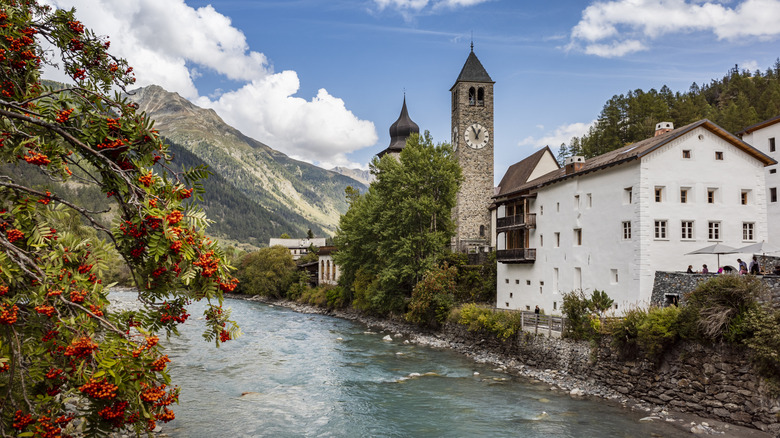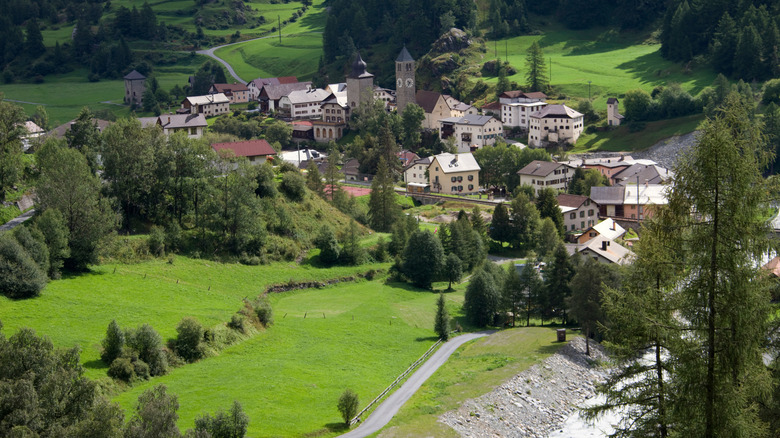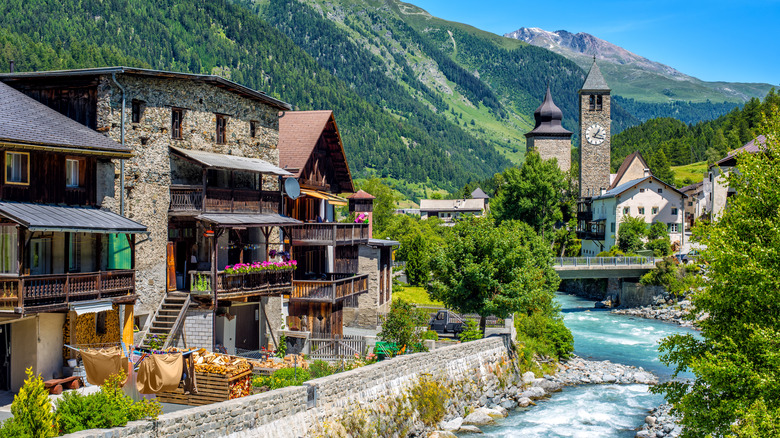The Artsy Swiss Village With Breathtaking Mountain Vistas And An Award-Winning Museum In A Monastery
For a relatively small country, Switzerland certainly packs a punch when it comes to epic alpine scenery, charming villages, lovely and historic cities, bucolic farmland, and those quintessential "the hills are alive" vibes. Switzerland is also a study in contrasts: The world's richest, modern banks in Zurich are interspersed with ancient churches. The villages are neat and clean, yet the chalet-style buildings are old. Tradition is strong in the mountains, yet the people have also embraced technology. Hardcore skiers live next door to cheese farmers, while the insanely efficient and well-run train system zooms past natural attractions like glaciers and thundering waterfalls.
The small village of Susch displays the contrasts of Switzerland like almost no other. The charming fairytale town, ideal for avoiding the crowded cities of Switzerland, lies in the Lower Engadin Valley near the turquoise waters of the Inn River and was once home to an ancient monastery. Today, the monks are all gone and the monastery has been converted into an art museum. And not just any art museum: an art museum dedicated almost entirely to oft-underappreciated women artists, many of whose incredible contributions to the art world (and the world in general) have gone unnoticed. How appropriate that the modern, wealthy, yet traditional Switzerland is home to a historic monastery that now houses a progressive museum amplifying underrepresented artists. And there is even more interesting contrasts to discover in Susch.
The picturesque Swiss village of Susch
It's hard to imagine a more idyllic Swiss Alpine village than Susch. The buildings cluster around an azure river, overlooked by the steeples of an ancient church (and former monastery). The ruins of the medieval Rohan Fortress watch over the town, as do stunningly green pastures and, of course, the dramatic peaks of the Alps. Susch originated as a "pass village," or a stopover on one of Switzerland's risky mountain passes. In Susch's case, the Flüela Pass once brought weary travelers, stagecoaches, and other intrepid souls crossing the Alps to the village's doors, seeking shelter and reprieve.
These days, it's best to reach Susch via train or car. Susch is a two- to three-hour train or car trip from Zurich, and about an hour away from the ritzy resort town of St. Moritz. Susch is also across the Engadin Valley from the famed town of Davos, the highest town in Europe, which also hosts the annual World Economic Forum. In the summer, one of the world's most beautiful train journeys is a mountain ride on the Glacier Express, traveling between Davos and the Matterhorn.
Susch is home to the unique Muzeum Susch
Susch, this under-the-radar, sleepy Swiss village that's like stepping into another world, is considered to be an "artsy haven," mostly thanks to its famed art museum. In addition, this reputation is thanks to an ancient art form that adorns many of the houses. Scraping plaster, or "sgraffito," is the art of carving intricate designs into the top layer of building plaster, revealing the color below. Likely brought over to the Engadin Valley from Italian artisans in the 16th century, the art form is now one of the enduring symbols of the valley. Explore one of Susch's traditional Engadin homes to see it on display, take a guided village tour to spot examples of sgraffito, or even take a lesson from a local craftsperson.
And then, of course, there's the Muzeum Susch. The monastery-turned-brewery was in ruins before being purchased by a Polish entrepreneur, Grażyna Kulczyk. She oversaw a thoughtful renovation from monastery to museum aimed to "balance a respect for the history of the building and creating space for a contemporary art museum," according to the museum's website. Museum Susch is a work of art in itself, complete with grottoes, underground passageways, and avant-garde pieces interspersed with fragments of history, like ancient water troughs. Both temporary and permanent exhibits highlight primarily modern female artists, as the museum's mission says that it "promotes the work of women in danger of drifting into the footnotes of art history" (via Sotheby's). In addition, a trip to the museum is quite accessible (as long as you plan ahead) since it is open Thursdays through Sundays, with an entry charge of 25 CHF ($28 USD). Discounts are offered for students, seniors, and children under the age of six.


